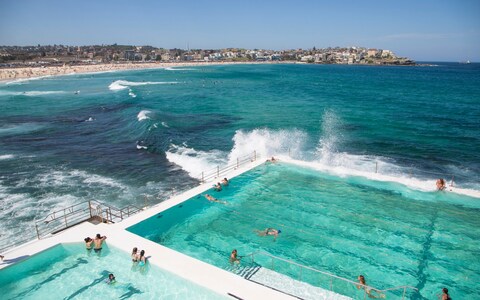How to retire to Australia – and navigate its ‘supers’ pensions
7 min readWith its hot weather, sandy beaches and high chances of a barbecue, Australia has long been a favourite for Britons searching for a sunny retirement.
The tax advantages of living down under only add to the appeal, but good financial planning is essential if you want to make the most of them. Otherwise, you could end up with some unexpected tax bills.
Here, Telegraph Money looks at what you need to know if you want to join the more than 225,000 British pensioners already living there.
What kind of visa will I need to move to Australia?
While the main “retirement visa” has been closed to new applicants, there are still other ways you can become a resident, as there are a large number of Australian visas.
There are three common routes that people use to become permanent residents of Australia: a “family-stream” visa, a “work-stream” visa, and a business or investor-stream visa.
The family-stream visa is for those with immediate family living in Australia, who can act as a sponsor. There are several different types, including age-dependent resident visa, carer’s visa, remaining relative visa and parent visa.
However, wait times and charges for some of these options can be pretty extreme – for example, those applying for some parent visas may have to wait almost 30 years for their claim to process, according to reports from earlier this year.
Applicants may also have to prove they have enough in savings or retirement income to provide for themselves.
Work-stream visas will be less applicable to those who have already retired, or who aren’t planning to work in Australia. To qualify, you either need to be sponsored by an Australian employer, or have skills that are valued in the country.
It’s also possible to get a business or investor-stream visa if you’re deemed to be a businessperson who can drive innovation and strengthen the Australian economy. Investors must have a net worth of at least $2.25m AUD, and be willing to invest at least $1.5m AUD in an Australian state or territory.
For a shorter term stay – perhaps while you’re scoping out somewhere to live, or deciding whether Australia is somewhere you want to retire – you can apply for a tourist visa of up to 12 months, at a cost of $190 AUD.

The Bondi Icebergs pools in Sydney, a city popular with British expats
Credit: Julieanne Birch/iStock
What will happen to your pension?
Australia can be a “very lucrative place to retire” from a pension perspective, said Philip Teague, executive director at Cross Border Financial Planning – but the rules are complicated, and you’ll need to interact with the country’s “superannuation scheme”.
If you have a UK pension you can transfer it to Australia using a “qualifying recognised overseas pension scheme”, known as Qrops – as long as it complies with regulations in both countries.
You can transfer a defined benefit (DB) pension scheme, a defined contribution (DC) pension scheme, an occupational pension scheme and a small self-administered scheme (SSAS).
But there are limits on how much you can move, and when. There is a transfer limit currently set at $110,000 AUD (around £58,000) a year, and those moving their pension must be at least 55 years old. Australian pensions are tax-free, and the only tax owed could be on the investment growth of a pension pot. But you might pay tax on what you transfer.
“There is some tax potentially to pay on the transfer over to Australia, but it’s going to typically be a lot less than what you would typically be paying if you left the money in the UK and pay tax in the UK,” Mr Teague said.
Transferring your pension to a non-Qrops could result in an authorisation charge of up to 55pc of the transferred amount, and the transfer being treated as taxable income. This would effectively mean you’ve been taxed on the income twice.
If you’re moving to Australia, Mr Teague said a “superannuation scheme”, commonly known as “supers”, would have to be created for you, or you can select one of the very few schemes that are already registered with HMRC. The trustees of that superannuation scheme would then apply to the UK for a qualifying overseas pension scheme registration.
Supers are a pension fund that all Australian employers must contribute to for each of their employees. They’re accessible from the age of 60, if you’ve retired, or 65 if you’re still working.
There will be taxes to pay based on the growth of the UK pension, from the time the individual became resident in Australia to the time that the money was moved over.
Peter Ferrigno, director of tax services at Henley & Partners, says: “The Australian pension system is very different to the UK, and pensions from superannuation schemes are tax-free, but this doesn’t necessarily apply to UK pensions.”
Additional taxes can also be levied if you don’t make the transfer within six months of moving to Australia.
But not all pensions can be transferred; this includes the state pension, annuities (in most cases) and unfunded public sector pensions.
You may still be able to claim your UK state pension while living in Australia, but you will face some issues. Firstly, while you live in Australia your state pension payments will not increase each year; British citizens currently see payments increase in line with the “triple lock”, but expats in Australia will have payments frozen.
Over time, the value of your payments will decrease, as they won’t keep up with rising prices.
State pension payments are made in British pounds, and may be subject to currency conversion fees, further reducing what you get. Finally, UK state pension payments may also be subject to tax.
What kind of taxes will you have to pay?
Investments such as interest, dividends and capital gains are all taxed as regular income in Australia, according to Henley & Partners.
Tax rates are similar to or slightly lower than in Britain. The tax-free personal allowance threshold is slightly lower than in Britain ($18,200 AUD or £9,400), but you’ll pay a lower rate of tax at 19pc. A higher rate of 32.5pc kicks in at $45,000- $120,000 AUD, you pay 37pc up to $180,000 AUD, and 45pc above that.
One thing to bear in mind is that Isa income is not recognised as being tax-free, meaning you can be charged CGT on any growth. If you’re not planning to return home, it’s worth considering weighing up whether you’d be better off selling the investments before you leave British shores.
As far as inheritance tax goes, Australia doesn’t have any. But that doesn’t mean you won’t be charged.
Mr Ferrigno said: “Australia doesn’t have inheritance, estate, gift or wealth taxes, but the usual rules for those retiring from the UK, still potentially being UK domiciled for inheritance tax purposes, will mean that it’s not always easy to escape IHT until you’ve put down roots in Australia.”
What kind of health cover do I need?
In most cases visitors to Australia do not have access to Medicare, so private health insurance is recommended to avoid getting stung by huge fees – and may be a part of your visa requirements.
Permanent visa holders are entitled to Medicare, which is the country’s public healthcare system, but many Australians also take out private health insurance to cover additional costs as it only applies to around 75pc of primary care charges.
There are two kinds of cover: hospital cover for some (or all) of the costs of hospital treatment as a private patient, and general treatment (“ancillary” or “extras”) cover for some non-medical health services not covered by Medicare – such as dental, physiotherapy and optical services.
As you’d expect, costs vary depending on the level of cover, as well as your age, medical history and location. The average cost is $157 AUD per month (£80), but you could end up paying far more.
How do I buy property in Australia?
Before buying a residential property in Australia, all international investors and temporary residents have to apply and be approved by the Foreign Investment Review Board (FIRB). The application cost is $14,100 AUD (£7,373) for properties worth $75,001 AUD (£39,200) to $1m AUD (£874,900), with higher fees payable the more expensive the home is.
It can be easier to purchase a property if you are a permanent resident or citizen, or buying a property jointly with either a citizen of Australia or New Zealand, or a permanent Australian visa holder.
While homebuyers are usually required to pay a 20pc deposit, many lenders ask for a 30pc deposit from foreign investors. Lenders may also impose higher interest rates.
All buyers have to pay stamp duty (also known as transfer duty), a land transfer fee and a mortgage application fee charged by the state government.
International investors pay a Foreign Citizen Stamp Duty surcharge of 8pc in New South Wales, Victoria and Tasmania. An additional 7pc is payable for Queensland, Western Australia and South Australia.



